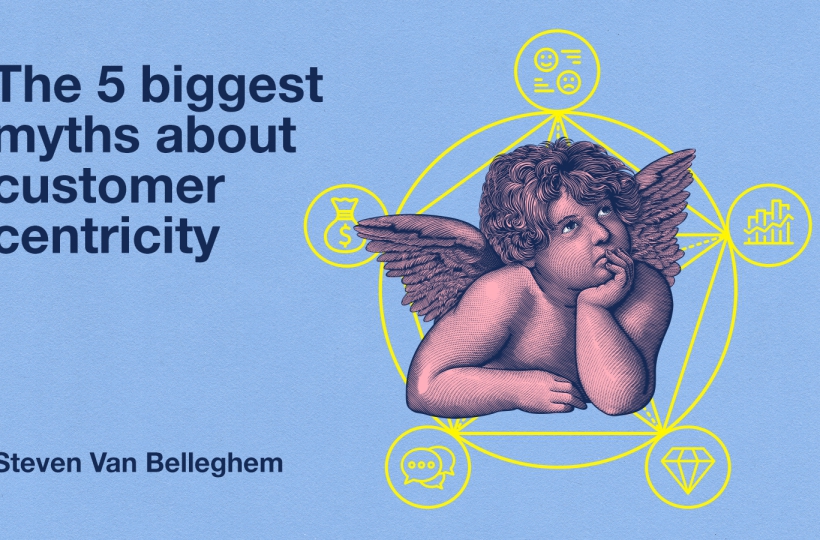The 5 biggest myths about customer centricity

Myth #1: customer centricity is asking customers what they want
Henry Ford’s quote “If I had asked my customers what they wanted they would have said faster horses” may be very old but it probably stuck around for a reason. A lot of brands still make the mistake of thinking that being customer centric is foremost about talking to customers, listening to them and executing their needs. But not all customer demands are realistic or even interesting for your other customers. It’s great that you organize customer communities, scan the social media and investigate all the place where they leave traces, but that is not the definition of customer centricity. It’s about finding ways of creating real value for most of your customers. Helping them save time on tedious tasks like grocery shopping is a good example, like Walmart did, with their Pickup Towers. It’s about making sure that you are easy to work with, like Uber. It’s about making them feel great in any way possible, like Tony Chocolonely, by offering delicious candy as well as the assurance that no one was harmed during the making of it.
Myth #2: Putting the customer at the centre is expensive
Improving a customer centric experience can be done in affordable steps. In fact, that is what I always recommend to my customers: it’s often better to change 10 small, but significant thing per month and improve the experience by 120X at the end of the year than to make one Big bet of which you do not have the certainty that it will work. Putting the customer at the centre of your company goes beyond expensive IoT driven solutions, facial recognition or other high-end tech (which can be fantastic, of course, but not everyone can afford them). I always love to give the example of Smartphoto and the enthusiastic lady that came up with the idea of sending gifts to people who had photographed weddings, anniversaries and all kinds of happy celebrations. Management had concerns about privacy, so they asked her to test her idea first with a gift budget of just 500 euros per month for 3 months but the result turned out to be overwhelmingly positive. So offering customer a great experience is definitely not always expensive.
Myth #3: Everything needs to be perfect
Fast adaptation is everything when it comes to being customer centric. If the customer changes direction, so should you. So if someone comes up with a great idea, don’t over-plan or overanalyse it until it’s 100% perfect. Launching something that is 90% good or that will make 90% of your customers a lot happier, is better than to wait too long and miss the boat. But it works the other way around, as well: if 90% of your customers behave well and 10% do not, please don’t make the 90% pay because of measures you take to keep the 10% bad guys in check. For example, Zalando made the clear and bold decision not to adapt its return policy because of those few rogues that send in the products damaged or much too late. It does not want to punish its best, most behaved customers and prefers to bear its ‘imperfect’ (for Zalando, not for the customer, I mean) return policy.
Myth #4: Metrics never lie
I wrote about this quite recently, but I wanted to include it here as well, because it’s such an important myth. Sometimes, companies measure the wrong things, or they use the wrong metrics. In these cases, numbers about customer centricity can lie. Let’s say that you would take ‘delivering top quality sustainable products’ as a strategy and then tie a metric of ‘less than 5% returns’ to that. You might expect that your team would gather data about the weak spots of returned products and then deliver this feedback to your engineers who could then improve them, which would result in less returns. But if your team is working towards the metric instead of the strategy, this following scenario would be far more likely: your service team could decide to make the return policy and process so complex, difficult and hard to find that the rate of returns would indeed plummet. This would be a very ‘clever’ shortcut of your service team, but the result would be a lot of frustrated customers and a dangerous informational blindness about the blind spots in your products. So make sure that you measure relevant things, and above all that you make sure that your metrics will not end up sabotaging the strategy they’re meant to support in the first place.
Myth #5: Customers first equals employees second
We all know employee horror stories of customer centric kings like Amazon where warehouse workers are afraid to go to the bathroom or take a sick day because of unattainable productivity targets. And I’m certain that working together with the very demanding customer genius Steve Jobs was not always a walk in the park. But in most cases, employee centricity does go hand in hand with customer centricity. If you’ve got a team that understands your strategy, your vision, your goals and feels part of something special, then you will end up with a high performing team thatwill do anything to please the customer. This employee centricity can and does happen in different ways. Nordstrom, for instance, which truly excels at CX, incentivizes its salespeople to help customers and delight them across every interaction. But it’s not always about monetary incentives. At NetApp, for instance, Vice Chairman Tom Mendoza regularly calls select employees to recognize them for doing their job just ‘right’. It’s just that simple: happy employees create happy customers. Employees that are tired, overstressed and unhappy will certainly not.